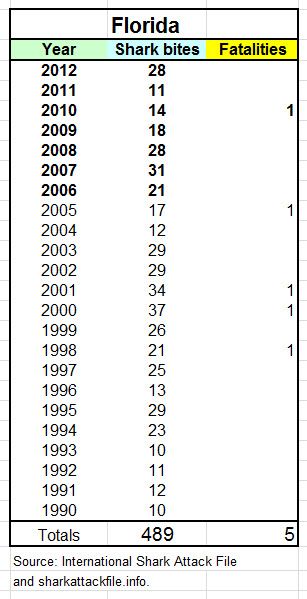
 |
Ocean Care Solutions provides effective, medically supported First-aid pain relief products for marine stings including the Portuguese Man O War, Stingray, Sea Urchin, Fire Coral and jellyfish sting injuries. |
 |
Sharks! Everyone's favorite fear. First you should accept that there are LOTS of sharks in the Gulf of Mexico and in the bay waters. There always have been. In fact, there are so many sharks that if they really wanted to eat people, you would never be able to swim in the water.
The fact is, sharks avoid people. I've watched large hammerhead sharks patrolling the beach in the morning. When they come upon a person swimming in the water, they make a large detour around the human. But sharks make mistakes. Sometimes the water is murky. Sometimes there are lots of fish around and the sharks are feeding recklessly. Sometimes people get chomped on. Most of the time the shark realizes its mistake and lets go with minor damage. But usually a few times a year, for some unknown reason, a large shark decides it wants an easy meal and attacks a person. I think it is aberrant behavior, but it does happen.
Shark Bites: How Many People are Bitten in Florida?
The data table below shows that between January 1990 and December 2012, out of 489 reported shark bites, only 5 were fatal. Thatís roughly 1 in 100 bites that results in death.

Since 1882 there have only been 11 recorded shark bite fatalities. Probably there were a few back in the late 1800's and early 1900's that were not recorded, but the point is that relative to the millions of people that swim in Florida waters, the rate of fatalities is very small indeed.
The numbers in the table for 1990 through 2012 come from the International Shark Attack File maintained by the Florida Museum of Natural History and from the database at SharkAttackSurvivors.com .
Since 1900, shark bites have increased in proportion to the population increase in Florida.
Between 1926 and 2011, more than half of Florida shark bites occurred during the months of July, August, September, and October. More than 85% of Florida shark bites occurred during the months March through October.
Most shark bites happen between 11am and 7pm, generally corresponding with the most popular times for water activities.
The feet, legs, and hands of surfers are the most common target of sharks in Florida, followed by swimmers and waders, and finally divers. Swimmers were the most common victim before the 1960ís. Surfing became popular beginning in the 1960ís and the exponential increase in the presence of surfers in the water contributed to a major increase in shark bites.
The most bites are inflicted by Spinner, Blacktip, Hammerhead, and Bull sharks.
What are Your Chances of Being Bitten?
Letís make some rough calculations by looking at the numbers for 2012. According to statistics kept by the United States Lifesaving Association on beach attendance, about 56,000,000 people visited Floridaís major public beaches. Florida averages about 16 shark bites per year. That works out to a chance of less than one in three million that any one person will be bitten by a shark.
Of course, there were more than 56 million visits to Floridaís most popular beaches in 2012. The above numbers were recorded at beaches with lifeguards. Many, if not more people swim at beaches without lifeguards. Itís also true that not everyone that goes to the beach actually goes in the water, and that historically, minor shark bites are under-reported. Overall, I think the 1 in three million estimate is reasonably conservative.
2,500 people are killed every year in FloridaÖin car crashes. Twenty five hundred. No kidding. And nearly 200,000 people are injured in car crashes each year in Florida. So, be careful driving to the beach.
If you want more information on dealing with the risk of shark bites in Florida, download my free Beach Survival Guide. It has lots more information on all kinds of hazards you might encounter at the beach as well as more info on sharks, including:
- Where in Florida most shark bites occur.
- How to reduce your chances of being bitten by a shark.
- Can you fight off a shark?
- How to help a shark bite victim.
Interesting Shark Information
If you're into data, charts, comparative analysis, statistics, etc. visit the International Shark Attack File page at the Museum Natural History by clicking on the following link: http://www.flmnh.ufl.edu/fish/Sharks/ISAF/ISAF.htm
Other cool shark links: For photos of Florida human/shark interactions click here http://gulfster.com/IndexFiles/SummerShark.html.
Here is a link to a popular video of a huge school of migrating sharks taken on Deerfield beach (Florida Atlantic coast). They are mostly blacktip and spinner sharks I understand. They appear like this for a few days and then disappear: http://www.nbc-2.com/BuildASX.asx?videofilename=050329_sharks.wmv&mswmext=.asx
